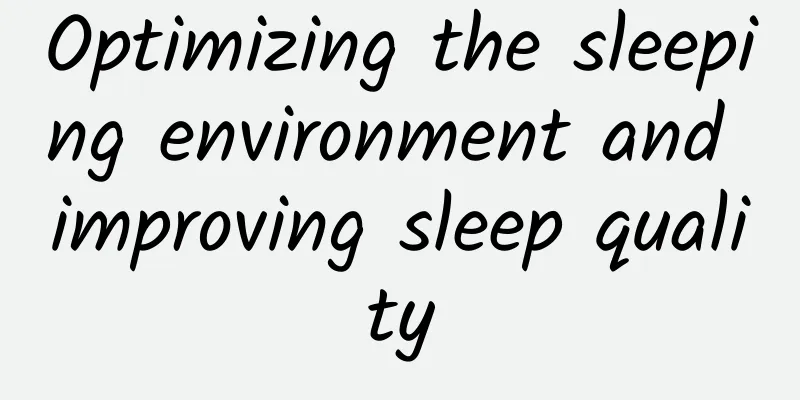Optimizing the sleeping environment and improving sleep quality

|
The full text is about 2,200 words and takes about 7 minutes to read. Sleep occupies one-third of human life, but its physiological mechanism has not been gradually revealed until the past 30 years. Modern neuroscience has found that sleep quality not only affects the energy of the next day, but is also directly related to the risk of Alzheimer's disease and cardiovascular disease. Optimizing sleep requires coordinated intervention from the three dimensions of environment, physiology, and psychology to form a systematic solution. 1. Environmental Control: From Physical Parameters to Neural Signals 1. Precision control of temperature and humidity Core data: In an environment of 18-22℃, the time to fall asleep is shortened by 37%. Physiological mechanism: A 0.5°C drop in body temperature triggers the hypothalamus to start the sleep program; when the humidity is below 40%, the dry nasal mucosa increases the number of awakenings by 2.3 times Technical solution: Intelligent temperature control mattress (phase change material temperature control error ±0.5℃) humidity linkage system 2. Bioengineering of light wavelengths Melatonin suppression threshold: Exposure to 480nm blue light (the wavelength of a mobile phone screen) 2 hours before bedtime reduces melatonin secretion by 53%. Interventions: 1800K amber light (simulates campfire spectrum) Smart curtains dynamically adjust lighting to 1-3 lux (moonlight intensity) 3. Active shaping of the acoustic environment Deep sleep killer: 40dB continuous noise (refrigerator hum) reduces stage N3 sleep by 28% Solution: Building sound insulation (soundproof windows reduce noise by 25dB) Pink noise (low-frequency white noise) increases slow-wave sleep duration by 19% 2. Circadian rhythm: Decoding the human body’s “invisible clock” 1. Regulatory logic of the suprachiasmatic nucleus (SCN) Light signal transduction: Retinal ipRGC cells transmit light signals to the SCN, regulating the circadian expression of 10% of genes Rhythm calibration: 5000 lux light exposure for 30 minutes in the morning can shift the biological clock phase forward by 2.1 hours 2. Melatonin kinetic model Secretion curve: Starts to rise at 21:00, peaks at 02:00, half-life 40 minutes Drug intervention: 0.3 mg sustained-release formulation can improve sleep efficiency by 22%, but long-term use can reduce receptor sensitivity by 63%. 3. Psychological intervention: Reconstructing the brain’s “sleep cognition” 1. Clinical evidence for cognitive behavioral therapy (CBT-I) Stimulus control: Staying out of bed for more than 20 minutes can improve sleep efficiency by 41% Sleep restriction: Compressing bed time to actual sleep duration × 1.2, deep sleep increased by 35% after 4 weeks 2. The vicious cycle of stress hormones Cortisol-melatonin antagonism: The nighttime cortisol level of stressed people increases by 32%, directly inhibiting melatonin synthesis Intervention options: Heart Rate Variability (HRV) Biofeedback Training Progressive muscle relaxation (PMR) reduces arousals by 58% 4. Social Engineering: The Ignored Sleep Killer 1. The cost of digital existence Screen time effect: For those who use screens for more than 5 hours a day, the latency to fall asleep is extended by 47 minutes. Dopamine hijack: Social media push every 20 minutes reduces the arousal threshold by 31% 2. Workplace stress model Managers’ dilemma: Mid-level managers have 1.7 times worse sleep quality than grassroots employees (stress hormone cortisol is 29% higher) Solution: 20 minutes of non-REM sleep in the afternoon (NASA research improves cognitive performance by 34%) Blue space therapy (exposure to water decreased stress hormones by 41%) Conclusion: The three dimensions of the sleep revolution require the establishment of an "environment-body-society" collaborative system to optimize sleep: use smart devices to achieve millimeter-level control of environmental parameters (temperature difference ≤ 0.5℃/light ≤ 1lux), and use CBT-I to rebuild neural plasticity (89% efficiency in 6 weeks). When individual sleep management is elevated to a social system engineering, humans may achieve a paradigm shift from survival time to quality of life. Data sources: American Academy of Sleep Medicine, Chinese Sleep Research Society, and Harvard Medical School. |
<<: Staying up late, catching up on sleep, snoring... You may have made these sleep mistakes
Recommend
What are the causes of waist pain in girls?
Lower back pain is a common condition for many wo...
What is the best food for uterine fibroids
Uterine fibroids are a gynecological disease that...
What are the advantages of ecological boards? What are the tips for choosing ecological boards?
Eco-boards are not very popular among those who a...
Can I see the gestational sac after 40 days of amenorrhea?
Vaginal ultrasound is the general name for intrav...
How are breast tumors graded?
The breast is the part that is most susceptible t...
What to give to someone who is in confinement?
For women who are in confinement, it is something...
Menstrual period delayed for 7 days and stomach pain
Normal women's menstruation is generally regu...
What are the reasons for amenorrhea during lactation?
After a woman has just given birth, her uterus is...
What to do if a girl has a bad temper
A bad temper can have a great impact on a person&...
What are the hazards of Qi and blood deficiency in women
What harm will women suffer from deficiency of bo...
What medicine should my wife take for her sexual frigidity?
Sexual life is indispensable for couples, because...
How to calculate the number of days of pregnancy after transplantation
For some couples, it is difficult to get pregnant...
What are the causes of body deficiency and cold uterus and how to treat it?
When women chat, they often bring up a topic, whi...
How big is the belly when pregnant for four months
By the fourth month of pregnancy, the enlarged ut...
How to treat menopausal depression? Please remember these reliable methods
Many women will experience depression during meno...









